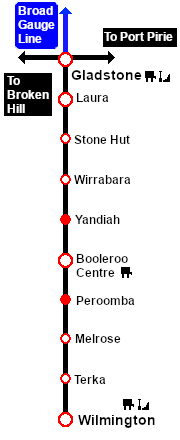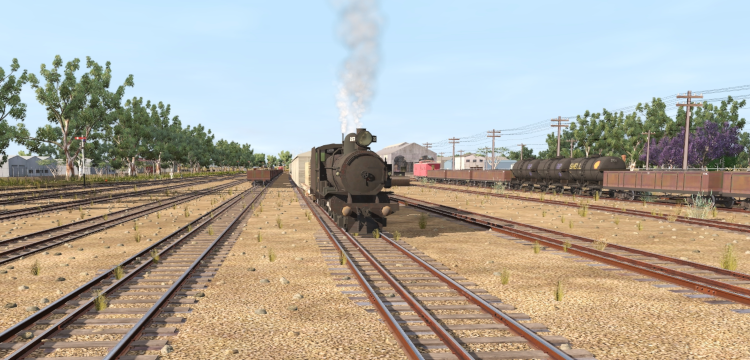SAR Gladstone
m |
m |
||
| Line 106: | Line 106: | ||
<tr valign="top"> | <tr valign="top"> | ||
<td> | <td> | ||
| − | + | <span style="font-weight: 700;"><span style="color: white; background-color: black;"> Distance from Port Pirie: </span> 52 kms, 32¼ miles <span style="color: white; background-color: black;"> from Peterborough: </span> 65½ kms, 40¾ miles</span><br> | |
| − | + | A major manned station, junction and a break-of-gauge location on the narrow gauge (3ft6in - 1067mm) <span style="font-weight: 700; color: white; background-color: black;"> Port Pirie-Broken Hill Line </span> and <span style="font-weight: 700; color: white; background-color: black;"> Gladstone-Wilmington Line </span>, and the broad gauge (5ft3in - 1600mm) <span style="font-weight: 700; color: white; background-color: blue;"> Gladstone-Hamley Bridge-Adelaide Line </span>.<br> | |
| − | + | Multiple loops, yards and sidings for goods, grain, livestock, station, transfer platforms and loco servicing facilities. Many of the tracks were dual gauge (narrow and broad gauge). To keep things simple, only a few dual gauge tracks are shown.<br> | |
| − | The '''Port Pirie-Broken Hill Line''' was converted to standard gauge during 1969-1970 and '''Gladstone''' then became a triple gauge location (narrow, standard and broad gauges) until the closure of the narrow and broad gauge lines by 1990.<br> | + | The '''Port Pirie-Broken Hill Line''' was converted to standard gauge (4ft8½in - 1435mm) during 1969-1970 and '''Gladstone''' then became a triple gauge location (narrow, standard and broad gauges) until the closure of the narrow and broad gauge lines by 1990.<br> |
At its peak, before standardisation, '''Gladstone''' employed over 1,000 workers in servicing locomotives and the break-of-gauge facilities.<br> | At its peak, before standardisation, '''Gladstone''' employed over 1,000 workers in servicing locomotives and the break-of-gauge facilities.<br> | ||
| − | '''Gladstone''' is now just a passing loop and a grain terminal. The loco servicing facilities have been removed. The station building still stands but is no longer in use | + | '''Gladstone''' is now just a passing loop and a grain terminal. The loco servicing facilities have been removed. The station building still stands but is no longer in use. Rail passenger services no longer stop at '''Gladstone''' and passengers now rely on a bus service. |
</td> | </td> | ||
</tr> | </tr> | ||
| Line 248: | Line 248: | ||
<tr valign="top"> | <tr valign="top"> | ||
<td> | <td> | ||
| − | + | <span style="font-weight: 700;"><span style="color: white; background-color: black;"> Distance from Port Pirie: </span> 52 kms, 32¼ miles <span style="color: white; background-color: black;"> from Peterborough: </span> 65½ kms, 40¾ miles</span><br> | |
| − | + | A major manned station, junction and a break-of-gauge location on the narrow gauge (3ft6in - 1067mm) <span style="font-weight: 700; color: white; background-color: black;"> Port Pirie-Broken Hill Line </span> and <span style="font-weight: 700; color: white; background-color: black;"> Gladstone-Wilmington Line </span>, and the broad gauge (5ft3in - 1600mm) <span style="font-weight: 700; color: white; background-color: blue;"> Gladstone-Hamley Bridge-Adelaide Line </span>.<br> | |
| − | + | Multiple loops, yards and sidings for goods, grain, livestock, station, transfer platforms and loco servicing facilities. Many of the tracks were dual gauge (narrow and broad gauge). To keep things simple, only a few dual gauge tracks are shown.<br> | |
| − | The '''Port Pirie-Broken Hill Line''' was converted to standard gauge during 1969-1970 and '''Gladstone''' then became a triple gauge location (narrow, standard and broad gauges) until the closure of the narrow and broad gauge lines by 1990.<br> | + | The '''Port Pirie-Broken Hill Line''' was converted to standard gauge (4ft8½in - 1435mm) during 1969-1970 and '''Gladstone''' then became a triple gauge location (narrow, standard and broad gauges) until the closure of the narrow and broad gauge lines by 1990.<br> |
At its peak, before standardisation, '''Gladstone''' employed over 1,000 workers in servicing locomotives and the break-of-gauge facilities.<br> | At its peak, before standardisation, '''Gladstone''' employed over 1,000 workers in servicing locomotives and the break-of-gauge facilities.<br> | ||
| − | '''Gladstone''' is now just a passing loop and a grain terminal. The loco servicing facilities have been removed. The station building still stands but is no longer in use | + | '''Gladstone''' is now just a passing loop and a grain terminal. The loco servicing facilities have been removed. The station building still stands but is no longer in use. Rail passenger services no longer stop at '''Gladstone''' and passengers now rely on a bus service. |
</td> | </td> | ||
</tr> | </tr> | ||
Revision as of 14:54, 8 September 2022
|
 |
|||||||||||||||||||||||||||||||||||



